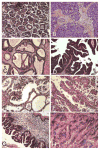Ovarian cancer: pathology, biology, and disease models
- PMID: 19273186
- PMCID: PMC2858969
- DOI: 10.2741/3364
Ovarian cancer: pathology, biology, and disease models
Abstract
Epithelial ovarian cancer, which comprises several histologic types and grades, is the most lethal cancer among women in the United States. In this review, we summarize recent progress in understanding the pathology and biology of this disease and in development of models for preclinical research. Our new understanding of this disease suggests new targets for therapeutic intervention and novel markers for early detection of disease.
Figures




References
-
- Jemal Ahmedin, Siegel Rebecca, Ward Elizabeth, Murray Taylor, Xu Jiaquan, Thun Michael J. Cancer statistics. CA Cancer J Clin. 2008;58:471–96. - PubMed
-
- Ozols Robert F. Chemotherapy for ovarian cancer. Semin Oncol. 1999;26:34–40. - PubMed
-
- McGuire William P, Hoskins William J, Brady Mark F, Kucera Paul R, Partridge Edward E, Look Katherine Y, Clarke-Pearson Daniel L, Davidson Martin. Cyclophosphamide and cisplatin compared with paclitaxel and cisplatin in patients with stage III and stage IV ovarian cancer. N Engl J Med. 1996;334:1–6. - PubMed
-
- Björkholm Elisabet, Pettersson Folke, Einhorn Nina, Krebs I, Nilsson Bjorn, Tjernberg B. Long-term follow-up and prognostic factors in ovarian carcinoma; the radiumhemmet series 1958 to 1973. Acta Radiol Oncol. 1982;21:413–9. - PubMed
-
- Högberg Thomas, Carstensen John, Simonsen Ernst. Treatment results and prognostic factors in a population-based study of epithelial ovarian cancer. Gynecol Onco. 1993;48:38–49. - PubMed
Publication types
MeSH terms
Grants and funding
LinkOut - more resources
Full Text Sources
Other Literature Sources
Medical

